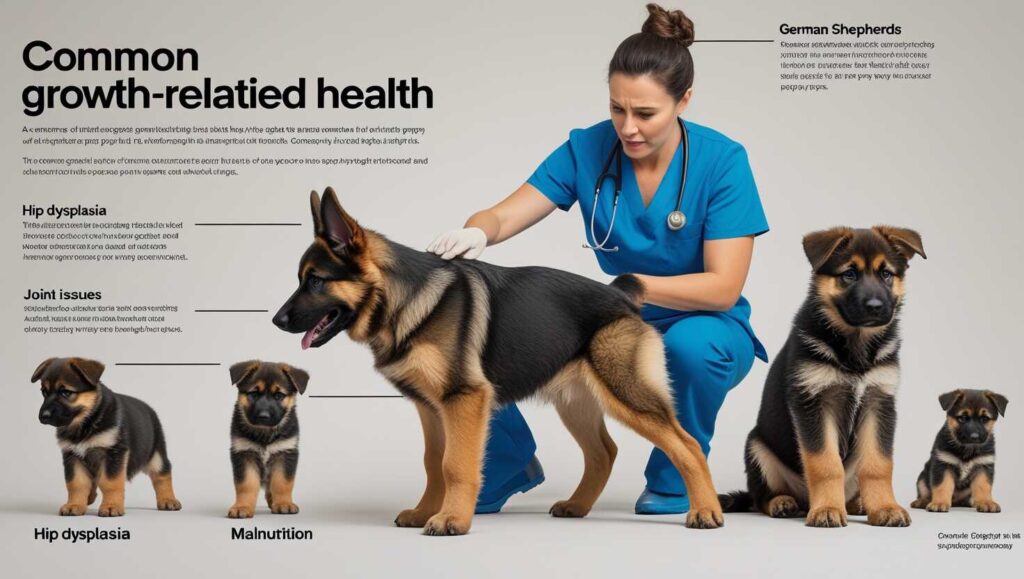When Do German Shepherds Stop Growing?

German Shepherds experience rapid growth in their first year, reaching near full height by 18 months, but may continue filling out until 2-3 years old. Factors like genetics, nutrition, and exercise influence their development. Regular vet checkups and a balanced diet ensure a healthy growth process.
Growth Stages of a German Shepherd
Early Growth Stages
A newborn German Shepherd puppy is tiny, weighing just a few ounces or grams, and relies fully on its mother’s milk for essential nutritional requirements. During the neonatal stage, which lasts a few weeks after birth, the dog needs plenty of sleep and warmth as its organs continue maturing. This period is crucial for growth and development, and since their immune system is still weak, they are highly susceptible to illnesses, making vet check-ups essential.
By a few months, the puppy enters an adolescent phase where the fastest growth occurs. This breed has breed-specific characteristics, with bones and muscles strengthening until they reach their physical maximum. Growth starts to eventually slow, but a proper diet and routine visits to the vet help avoid health issues. As they adapt to different environments, early social interactions with animals shape their behavior. Meeting nutritional requirements and preventing serious diseases through care and the right temperatures ensures healthy development.
Developmental Phases
A German Shepherd experiences rapid growth in its first few weeks, entering the transitional phase where its eyes open, and teeth start coming in. At this moment, the puppy begins to explore its environment, shifting from mother’s milk to solid food. By 2 to 4 months, their personality starts to develop, making positive reinforcement in training crucial.
By three to six months, the dog reaches a childhood stage, similar to a human pre-teen. At 4.5 to 8 months, females grow 4.5 to 8 inches, while males reach 5.5 to 9 inches in height. Their weight increases to around 49 to 50 pounds by one year. Veterinarians suggest this is the median age when the overall growth moves towards maturity, but full size may take up to seven years to break through completely.
Maturity Stages
A German Shepherd’s physical maturity happens between two and three years of age. Males typically weigh between 79 and 88 pounds, reaching a height of 24 to 26 inches, while females grow to 22 inches and 70 pounds. Their growth begins to slow after eight months, and a stable diet helps them transition into the adult dog stage.
During this period, owners should reinforce essential behaviors from puppyhood, focusing on mental stimulation and advanced obedience training. Their alert nature makes them excel in search and rescue operations, drug and armament detection, herding, and protection sports. Engaging in scenting games and activities keeps them healthy and moderately active.
As they grow older, their body becomes weaker, requiring supplements for a strong immune system. Senior dogs may face age-related ailments like arthritis, cognitive decline, hearing, and vision loss. Regular veterinarian visits and proper medical care help manage these changes effectively.
Growth and Weight Charts
Male Growth Charts
Male German Shepherds experience significant growth, typically reaching their full adult size between 18 and 24 months. During adolescence, from 6 to 24 months, their development is especially rapid, with noticeable increases in both muscle and bone mass. Between 12 and 24 months, they can grow up to 4 inches taller and gain as much as 30 pounds.
Here’s a chart depicting the growth rate of male German Shepherd puppies:
| Age | Height | Weight |
| 1 month | 4 – 6″ (10 – 15 cm) | 5.5 – 9 lbs (2.5 – 4 kg) |
| 2 months | 7 – 9″ (18 – 23 cm) | 16 – 20 lbs (7 – 9 kg) |
| 3 months | 9 – 11″ (23 – 28 cm) | 22 – 30 lbs (10 – 13.5 kg) |
| 4 months | 11 – 14″ (28 – 35 cm) | 35 – 40 lbs (16 – 18 kg) |
| 5 months | 14 – 16″ (35 – 40 cm) | 40 – 49 lbs (18 – 22 kg) |
| 6 months | 16 – 18″ (40 – 46cm) | 49 – 57 lbs (22 – 26 kg) |
| 7 months | 18 – 20″ (46 – 51 cm) | 57 – 62 lbs (26 – 28 kg) |
| 8 months | 20 – 22″ (51 – 56 cm) | 62 – 66 lbs (28 – 30 kg) |
| 9 months | 21 – 23″ (53 – 58 cm) | 64 – 71 lbs (29 – 32 kg) |
| 10 months | 22 – 24″ (55 – 61 cm) | 66 – 73 lbs (30 – 33 kg) |
| 11 moths | 22 – 24″ (55 – 61 cm) | 71 – 75 lbs (32 – 34 kg) |
| 1 year | 22 – 24″ (55 – 61 cm) | 71 – 79 lbs (32 – 36 kg) |
| 1.5 years | 23 – 25″ (58 – 64 cm) | 71 – 79 lbs (32 – 36 kg) |
| 2 years | 23 – 25″ (58 – 64 cm) | 71 – 84 lbs (32 – 38 kg) |
| 3 years | 24 – 26″ (61 – 66 cm) | 79 – 88 lbs (36 – 39 kg) |
Female Growth Charts
Female German Shepherds typically reach their full adult size earlier than males, usually between 18 and 20 months. While they may not grow as large as their male counterparts, their adolescent growth phase, from 6 to 18 months, is just as remarkable. During this stage, they can gain up to 3 inches in height and add as much as 22 pounds in weight.
Here’s a chart depicting the growth rate of female German Shepherd puppies:
| Age | Height | Weight |
| 1 month | 3 – 6″ (7.5 – 15 cm) | 4.5 – 8 lbs (2 – 3.5 kg) |
| 2 months | 6 – 9″ (15 – 23 cm) | 11 – 17 lbs (5 – 8 kg) |
| 3 months | 8 – 10″ (20 – 25.5 cm) | 17 – 26 lbs (8 – 12 kg) |
| 4 months | 10 – 12″ (25.5 – 30 cm) | 31 – 35 lbs (14 – 16 kg) |
| 5 months | 12 – 14″ (30 – 35.5 cm) | 35 – 44 lbs (16 – 20 kg) |
| 6 months | 15 – 17″ (38 – 43 cm) | 44 – 49 lbs (20 – 22 kg) |
| 7 months | 17 – 19″ (43 – 48 cm) | 49 – 53 lbs (22 – 24 kg) |
| 8 months | 18 – 20″ (45.5 – 51 cm) | 53 – 57 lbs (24 – 26 kg) |
| 9 months | 19 – 21″ (48 – 53.5 cm) | 55 – 60 lbs (25 – 27 kg) |
| 10 months | 19 – 21″ (48 – 53.5 cm) | 57 – 62 lbs (26 – 28 kg) |
| 11 months | 20 – 22″ (51 – 56 cm) | 60 – 64 lbs (27 – 29 kg) |
| 1 year | 20 – 22″ (51 – 56 cm) | 60 – 64 lbs (27 – 29 kg) |
| 1.5 years | 21 – 22″ (53.5 – 56 cm) | 60 – 66 lbs (27 – 30 kg) |
| 2 years | 21 – 22″ (53.5 – 56 cm) | 60 – 66 lbs (27 – 30 kg) |
| 3 years | 22 – 24″ (56 – 61 cm) | 66 – 70 lbs (27 – 32 kg) |
When Do German Shepherds Stop Growing?

General Growth Timeline
A German Shepherd is a large breed, and its growth rate is rapid in the first few months. A puppy starts as a small bundle of fur but quickly jumps in size. By 18 months, a male can reach 26 inches in length, while a female is slightly smaller. Their chest and abdomen expand as they near the full-grown mark, though some continue growing until two and a half years.
By 24 months, the majority of German Shepherds hit their true adult size. Maturity brings a final growth spurt, where they may see a 10 percent increase in weight, reaching around 75 pounds for males and 55 to 70 pounds for females. According to the American Kennel Club Standard, genetic and environmental factors impact their final size. Checking a weight chart helps gauge their progress.
Even at older stages, their paws can indicate how much they still need to grow. A breeder or veterinarian can provide an estimated percentile based on the parents and litter. While a full-grown dog is usually set by 36 months, monitoring for obesity is crucial. When you adopt a puppy, it may seem like an adorable handful, but expect an energetic adolescent before reaching its largest size.
Growth Differences Between Males and Females
A male German Shepherd stops growing between 24 to 36 months, reaching its full adult size. These dogs are physically larger, with more muscle mass, greater weight, and increased height and length. Their growth happens at a slower rate due to hormones, which decrease as the dog ages.
A female matures earlier than her male counterparts, typically between 20 to 30 months. While smaller, her growth is influenced by genetics and diet. Though less muscular, she still reaches a strong adult form within this timeframe.
Factors Affecting Growth
How Genetics and Biology Affect Growth
Like a human, a dog follows a unique growth pattern influenced by genetics. A German Shepherd’s final size depends on its parents and genealogy, with some growing larger while others remain smaller. Their potential growth also ties to overall health, making wellness products and a balanced diet essential for a healthy, happy life.
Poor nutrition can lead to obesity, skeletal problems, and low energy levels. A high-quality, protein-rich food with proper proteins, carbohydrates, fats, vitamins, and minerals supports strong bones, joints, and muscles. Regular exercise, including walking and playing, keeps them fit and mentally stimulated, preventing development issues.
As an active herding breed, the German Shepherd needs physical activity and regular vet visits. Vaccinations protect against preventable diseases like rabies, distemper, and parvovirus, reducing the risk of costly treatments. A certified veterinarian, as recommended by the AVMA, ensures the best lifestyle for your pet, keeping them safe from illnesses carried by animals, people, and wildlife.
Environmental and Behavioral Factors
Socialization and Development
Socialization is vital for a pup’s development and behavior. Early exposure to animals, people, and different environments helps them interact and respond appropriately. Regular playdates, walks, and visits to public places allow them to socialize, reducing risks of depression, fear, or aggressive tendencies.
Health and Medical Care
If a dog’s hormones lag due to stress or illness, it may face gastrointestinal disorders, immunosuppression, or endocrine abnormalities. Protection from infectious agents like parvovirus, distemper, and rabies is crucial. Routine checkups with a veterinarian ensure proper medical care, including shots and vaccines to prevent infected wounds, dehydration, vomiting, and diarrhea.
Training and Positive Reinforcement
Training helps create loyal, obedient companions. Teaching basic commands like sit, stay, and come strengthens the bond between the owner and the dog. Using positive rewards, such as treats, toys, and mental stimulation, enhances engagement and prevents problem behaviors like barking, chewing, or aggression.
Mental Stimulation and Grooming
To prevent destructive habits, engage in brain games like puzzle challenges, problem-solving, hide-and-seek, fetch, and tug-of-war. Toys like Kongs, hollow chews filled with peanut butter, and other enrichment tools reduce stress and protect furniture. Regular grooming, including brushing, bathing, and nail care, keeps the coat glossy, removes dander, and prevents mats, skin issues, and scrapes caused by poor hygiene.
Health Concerns Related to Growth

Monitoring Overall Health
- Preventive care is the key to a healthy, long life for a dog.
- A well-rounded diet and regular exercise help maintain an optimal weight.
- The American Veterinary Medical Association states that early monitoring improves life expectancy.
- By two years, regular vet visits ensure an ideal lifestyle, adjusting:
- Food quantity
- Treats
- Appointments with an experienced veterinarian
Common Health Risks
- Breed-specific conditions to watch for:
- Gastric dilatation-volvulus (bloat) in large, deep-chested breeds
- Hip problems requiring ongoing tests
- Monitoring health reduces costs of illnesses, accidents, and treatment, which can cost thousands of dollars.
Importance of Insurance and Checkups
- Dog insurance or wellness plans offer peace of mind for emergency expenses.
- Annual vaccinations, exams, and microchips help track growth and detect discrepancies.
- Consult a vet if a dog is:
- Growing too slow or fast
- Showing concern over development patterns
Proper Nutrition and Feeding
- A nutritional deficiency, improper feeding schedule, or incorrect portions can:
- Make a dog underweight or overweight
- Cause serious health risks
- Adjusting meals based on energy needs supports a healthy gastrointestinal tract and prevents long-term problems.
Growth-Related Health Conditions
Exocrine Pancreatic Insufficiency (EPI)
- A digestive disorder where the pancreas does not produce enough enzymes.
- Leads to metabolic issues and weight loss.
- This syndrome can develop between six months and six years.
- Proper dietary management with balanced fats is crucial.
Parasite Infections
- This breed is susceptible to parasites, increasing infection risk.
- Deworming medication helps prevent whipworm and other nutrient-leaching worms.
- Common symptoms include nutritional deficiency and poor digestion.
- Feeding raw food without proper care may worsen the issue.
Diabetes Mellitus
- Affects how insulin helps metabolize sugars.
- Can become severe in a short period, especially for dogs four years or older.
- Regular monitoring of diet and exercise helps prevent complications.
Hemangiosarcoma (HSA) – Cancer Risk
- A deadly cancer affecting the vascular endothelium.
- Has a three percent occurrence in German Shepherds.
- Commonly appears between nine and 12 years.
- Proper nutritional requirements, quality meat, and veterinarian checkups help with early monitoring.
- Regular exercise supports overall health.
Common Health Issues in German Shepherds
Hip Dysplasia
- A condition where the joints become unstable, leading to inflammation and deterioration.
- Causes painful limping, stiffness, and an abnormal gait.
- Signs include:
- Difficulty maintaining a seated position
- Muscle wasting and lameness
- Increased risk of arthritis as the joints break down
- Swelling around the affected area
Gastric Dilatation-Volvulus (GDV) – Bloat
- Affects dogs with deep chests, where the stomach flips, blocking blood flow.
- Can be fatal without medical care.
- Symptoms include:
- Retching with no ability to vomit
- Abdominal distension and weakness
- Pale gums, weak pulses, and sudden collapse
Epilepsy and Degenerative Disc Disease
- Epilepsy is a seizure disorder caused by neurological abnormalities, usually appearing between two and four years of age.
- Degenerative disc disease leads to canine spine deterioration, causing:
- Extreme pain and paralysis
- Rigid posture and crying
- Knuckling of the hind paws
- Difficulty moving limbs
Regular checkups and early detection of these prevalent conditions can improve a German Shepherd’s quality of life.
Kindly note: The content shared in this blog is gathered from online sources, some of which may not be verified. For accurate guidance on caring for your dog, it is recommended to seek advice from a qualified veterinarian.
FAQs
Will Spaying/Neutering My German Shepherd Too Early Affect Their Growth?
Spaying or neutering your German Shepherd at the wrong time can impact their health and behavioral development. Veterinary professionals suggest the best time for sterilization is between six to 12 months, depending on their specific needs and status. Early spay or neuter can significantly decrease the risk of reproductive cancers and infections but may also affect hormones, influencing behaviors like aggression, desire to roam, and struggles with training. Consult your vet to determine the ideal timeframe.
When Should My German Shepherd Stop Eating Puppy Food?
Puppy food is essential for a growing canine, providing the right ingredients for a healthy future. Since this large breed goes through extended growth periods, they should continue consuming high-calorie meals until around 18 months. The transition to adult dog food should be gradual, ensuring they maintain a healthy size without excessive weight gain.
When Will My German Shepherd Start Losing Teeth?
Like children, baby teeth in puppies begin to fall out between three to six weeks, making room for permanent teeth. As the new teeth erupt, you may notice discomfort in their gums, leading to chewing behaviors. Providing chew toys can help ease this process.
When Should I Start Training My German Shepherd?
Training should start as early as eight weeks. A well-structured program helps build intelligence and purpose, leading to strong obedience. Early socialization with pets and people reduces aggression, making them more well-rounded and manageable.
What Commands Should I Teach My German Shepherd First?
Basic commands like sit, stay, lay down, come, and drop are important for early learning. Since German Shepherds are highly loyal, proper training ensures they become protective but not overly aggressive, making them a productive part of the family.
When Will My German Shepherd Calm Down?
This breed is known for its high energy and remains playful through teenage years. Around four years, they transition into adulthood and become more settled. Proper exercise, structured training, and regular activities like public parks, trails, and exposure to unfamiliar settings help manage hyperactive behaviors. Ensuring they are vaccinated against parvovirus and distemper allows for safe outdoor experiences.

